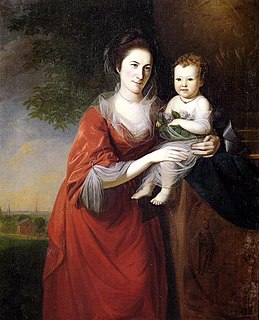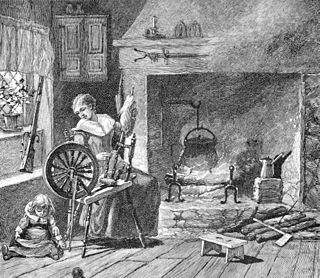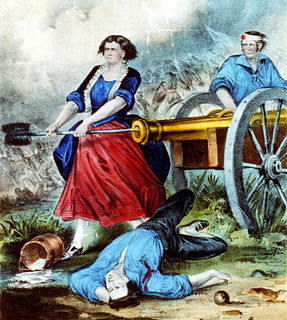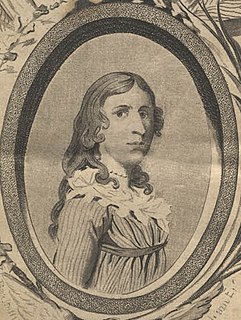 W
WThe Edenton Tea Party was a political protest in Edenton, North Carolina, in response to the Tea Act, passed by the British Parliament in 1773. Inspired by the Boston Tea Party and the calls for tea boycotts and the resolutions of the first North Carolina Provincial Congress, 51 women, led by Penelope Barker, met on October 25, 1774, and signed a statement of protest vowing to give up tea and boycott other British products "until such time that all acts which tend to enslave our Native country shall be repealed."
 W
WWomen in the American Revolution played various roles depending on their social status and their political views.
 W
WAgent 355 was the code name of a female spy during the American Revolution, part of the Culper Ring. Agent 355 was one of the first spies for the United States, but her real identity is unknown. The number, 355, could be decrypted from the system the Culper Ring used to mean "lady."
 W
WAbigail Adams was the wife and closest advisor of John Adams, as well as the mother of John Quincy Adams. She is sometimes considered to have been a Founder of the United States, and is now designated as the first second lady and second first lady of the United States, although these titles were not used at the time. She and Barbara Bush are the only two women to be married to one U.S. president and the mother of another.
 W
WHannah Adams was an American author of books on comparative religion and early United States history. She was born in Medfield, Massachusetts and died in Brookline. Adams was the first woman in the U.S. who worked professionally as a writer.
 W
WKatharine Greene Amory was an 18th-century Bostonian known for the journal she kept during the American Revolution. It is valued by historians for its record of daily life and for its window onto the viewpoint of a Loyalist woman.
 W
WSarah "Sally" Franklin Bache was the daughter of Benjamin Franklin and Deborah Read. She was a leader in relief work during the American Revolutionary War and frequently served as her father's political hostess, like her mother before her death in 1774. Sarah was also an important leader for women in the pro-independence effort in Philadelphia. She was an active member of the community until her death in 1808.
 W
WPenelope Barker was an activist in the American Revolution who organized a boycott of British goods in 1774 known as the Edenton Tea Party.
 W
WCatherine Moore Barry was a heroine of the American Revolutionary War. She was the daughter of Charles and Mary Moore, and the eldest of ten children. She married Andrew Barry in 1767 at the age of 15 and lived on Walnut Grove Plantation in Roebuck, South Carolina during the 18th century. She was instrumental in helping to warn the militia of the coming British before the Battle of Cowpens in 1781. According to legend, she tied her toddler to the bedpost while she rode out to warn neighbors that the British were coming.
 W
WAnn Bates was a loyalist spy during the American Revolution. Originally from Philadelphia, Pennsylvania, Bates was known for her awareness, her intelligence, and her ability to remain calm under pressure. She was commonly referred to as "Mrs. Barnes" by affiliates in her spy networks. She was known to carry an unknown unique token that would eventually identify her as a British spy. She would go on to become a part of British General Clinton's espionage network, and would help the British combat American forces on several fronts. She reportedly took part in various clandestine spy missions between 1778 and 1780. Bates was most well known for her missions completed at George Washington's base camp in White Plains, New York, and during the Rhode Island Campaign or the Battle of Rhode Island.
 W
WAnn Eliza Bleecker was an American poet and correspondent. Following a New York upbringing, Bleecker married John James Bleecker, a New Rochelle lawyer, in 1769. He encouraged her writings, and helped her publish a periodical containing her works.
 W
WMolly Brant, also known as Mary Brant, Konwatsi'tsiaienni, and Degonwadonti, was a Mohawk leader in British New York and Upper Canada in the era of the American Revolution. Living in the Province of New York, she was the consort of Sir William Johnson, the British Superintendent of Indian Affairs, with whom she had eight children. Joseph Brant, who became a Mohawk leader and war chief, was her younger brother.
 W
WMary Willing Byrd was an American planter.
 W
WMargaret Cochran Corbin was a woman who fought in the American Revolutionary War. On November 16, 1776, her husband, John Corbin, was one of some 600 American soldiers defending Fort Washington in northern Manhattan from 4,000 attacking Hessian troops under British command. Margaret, too nervous to let her husband go into battle alone, decided she wanted to go with him. Since she was a nurse, she was allowed to accompany her husband as a nurse for injured soldiers. John Corbin was on the crew of one of two cannons the defenders deployed; when he fell in action, Margaret Corbin took his place and continued to work the cannon until she too was seriously wounded. It is said that Corbin was standing next to her husband when he fell during battle. Immediately, she took his post, and because she had watched her husband, a trained artilleryman, fire the cannon so much, she was able to fire, clean and aim the cannon with great ease and speed. This impressed the other soldiers and was the beginning of her military career. She later became the first woman in U.S. history to receive a pension from Congress for military service when she could no longer work due to injury, and was enlisted into the Corps of Invalids.
 W
WLydia Darragh was an American woman said to have crossed British lines during the British occupation of Philadelphia, Pennsylvania during the American Revolutionary War, delivering information to George Washington and the Continental Army that warned them of a pending British attack. Contemporary sources claim Darragh's uncorroborated story is historically unsubstantiated.
 W
WEsther de Berdt Reed was active in the American Revolutionary War as a civic leader for soldiers' relief, who formed and led the Ladies Association of Philadelphia to provide aid for George Washington's troops during the war.
 W
WMary "Polly" Norris Dickinson was an early American land and estate owner and manager. She is known for her ownership of one of the largest libraries in the American colonies, her participation in political thought of the time, and her presence in or near events of the Constitutional Convention, including her marriage to Framer John Dickinson, one of the early drafters of the Constitution and one of its signers on behalf of the colony of Delaware. They bequeathed much of their combined library to the first college founded in the new United States. The college was originally named "John and Mary's College", by Benjamin Rush, for Norris Dickinson and her husband and is now called Dickinson College.
 W
WMargaretta Faugères was the daughter of Ann Eliza Bleecker. She was an American playwright, poet and political activist. She became distinguished after the American Revolutionary War, in New York City's fashionable society, as a gifted and accomplished woman, although her married life was rendered unhappy by a profligate husband. After his death in 1798, she assisted in a female academy in New Brunswick; but her sufferings were said to have "broken her heart". She died at the early age of twenty-nine.
 W
WElizabeth Freeman, also known as Bet, Mum Bett, or MumBet, was the first enslaved African American to file and win a freedom suit in Massachusetts. The Massachusetts Supreme Judicial Court ruling, in Freeman's favor, found slavery to be inconsistent with the 1780 Massachusetts State Constitution. Her suit, Brom and Bett v. Ashley (1781), was cited in the Massachusetts Supreme Judicial Court appellate review of Quock Walker's freedom suit. When the court upheld Walker's freedom under the state's constitution, the ruling was considered to have implicitly ended slavery in Massachusetts.Any time, any time while I was a slave, if one minute's freedom had been offered to me, and I had been told I must die at the end of that minute, I would have taken it—just to stand one minute on God's airth [sic] a free woman— I would.
 W
WMargaret Kemble Gage (1734–1824) was the wife of General Thomas Gage, who led the British Army in Massachusetts early in the American Revolutionary War. She was born in New Brunswick, Province of New Jersey and resided in East Brunswick Township. She died in England in 1824. Mrs. Gage was a gateway ancestor to centuries of English nobility who have Dutch and Huguenot ancestry from what was once New Netherlands and later the Thirteen Colonies of British North America.
 W
WMary Katharine Goddard was an early American publisher, and the postmaster of the Baltimore Post Office from 1775 to 1789. She was the second printer to print the Declaration of Independence. Her copy, the Goddard Broadside, was commissioned by Congress in 1777, and was the first to include the names of the signatories.
 W
WNancy Morgan Hart was a rebel heroine of the American Revolutionary War noted for her exploits against Loyalists in the northeast Georgia backcountry. She is characterized as a tough, resourceful frontier woman who repeatedly outsmarted Tory soldiers, and killed some outright. Stories about her are mostly unsupported by contemporary documentation, and it has been impossible for researchers to entirely distinguish fact from folklore.
 W
WThe homespun movement was started in 1767 by Quakers in Boston, Massachusetts, to encourage the purchase of goods, especially apparel, manufactured in the American Colonies. The movement was created in response to the British Townshend Acts of 1767 and 1768, in the early stages of the American Revolution.
 W
WSybil Ludington, April 5, 1761 – February 26, 1839, was a heroine of the American Revolutionary War. On April 26, 1777, the 16 year-old daughter of a colonel in the Colonial Militia, Henry Ludington, made an all-night horseback ride to alert militia forces in the neighboring towns of what is today's Putnam County, New York of the burning of Danbury, Connecticut by British forces.
 W
WFlora MacDonald ; was a member of the Macdonalds of Sleat and the MacDonalds of Clanranald, who helped Charles Edward Stuart evade government troops after the Battle of Culloden in April 1746. Her family supported the government during the 1745 Rising and Flora later claimed to have assisted Charles out of sympathy for his situation.
 W
WJane McCrea was an American woman who was killed by a Native American warrior serving alongside a British Army expedition under the command of John Burgoyne during the American Revolutionary War. Engaged to a Loyalist officer serving under Burgoyne, her death lead to widespread outrage in the Thirteen Colonies and was used by Patriots as part of their anti-British propaganda campaign.
 W
WMary Lindley Murray is known in the American Revolution as the Quaker woman who in 1776 held up British General William Howe after the British victory against American forces at Kips Bay.
 W
WNonhelema Hokolesqua Born in 1718 into the Chalakatha (Chilliothe) division of the Shawnee nation and spent her early youth in Pennsylvania. Her brother Cornstalk, and her metis mother Katee accompanied her father Okowellos to the Alabama country in 1725. Their family returned to Pennsylvania within five years. In 1734 she married her first husband, a Chalakatha chief. By 1750 Nonhelema was a Shawnee chief during the 18th century and the sister of Cornstalk, with whom she migrated to Ohio and founded neighboring villages.
 W
WMary Ludwig Hays was a woman who fought in the American War of Independence at the Battle of Monmouth. The woman behind the Molly Pitcher story is most often identified as Hays, but it is likely that the legend is an amalgam of more than one woman seen on the battlefield that day.
 W
WElizabeth Willing Powel was an American socialite and a prominent member of the Philadelphia upper class of the late 18th and early 19th centuries. The daughter and later wife of mayors of Philadelphia, she was a salonnière who hosted frequent gatherings that became a staple of political life in the city. During the First Continental Congress in 1774, Powel opened her home to the delegates and their families, hosting dinner parties and other events. After the American Revolutionary War, she again took her place among the most prominent Philadelphian socialites, establishing a salon of the Republican Court of leading intellectuals and political figures.
 W
WThe Republican Court was a group of American political figures, intellectuals, and their spouses which formed in the late 1700s and early 1800s around the president and first lady of the United States. It centered around social gatherings at the home of George and Martha Washington in Philadelphia, and more broadly among the various social elite of the city. As an informal political association, it provided an important avenue for women to participate in discourse on political philosophy and matters of state.
 W
WFrederika Charlotte Louise von Massow, Baroness (Freifrau) Riedesel zu Eisenbach (1746-1808) was a German writer. She was the wife of General Friedrich Adolf Riedesel of Brunswick. She accompanied him during the Saratoga Campaign in the American Revolutionary War and kept a journal of the campaign.
 W
WElizabeth Griscom Ross, also known by her second and third married names, Ashburn and Claypoole, was an American upholsterer who was credited by her relatives in 1870 with making the first American flag, accordingly known as the Betsy Ross flag. Though most historians dismiss the story, Ross family tradition holds that General George Washington, commander-in-chief of the Continental Army and two members of a congressional committee—Robert Morris and George Ross—visited Mrs. Ross in 1776. Mrs. Ross convinced George Washington to change the shape of the stars in a sketch of a flag he showed her from six-pointed to five-pointed by demonstrating that it was easier and speedier to cut the latter. However, there is no archival evidence or other recorded verbal tradition to substantiate this story of the first American flag. It appears that the story first surfaced in the writings of her grandson in the 1870s, with no mention or documentation in earlier decades.
 W
WDeborah Sampson Gannett, better known as Deborah Sampson, was a Massachusetts woman who disguised herself as a man in order to serve in the Continental Army during the American Revolutionary War. She is one of a number of women with a documented record of military combat experience in that war. She served 17 months in the army under the name "Robert Shirtliff" of Uxbridge, Massachusetts, was wounded in 1782, and was honorably discharged at West Point, New York, in 1783.
 W
WSally St. Clair was an American woman from South Carolina who disguised herself as a man and joined the Continental Army. Her true gender was not discovered until after she was killed in battle during the Siege of Savannah in 1782.
 W
WMolly Stark, née Elizabeth Page, was the wife of General John Stark, made famous by his battle cry during the American Revolutionary War. Described as "mother of 11 children, homemaker, patriot, and defender of the household", there are locations and landmarks named for her in at least four states.
 W
WNanyehi, known in English as Nancy Ward, was a Beloved Woman and political leader of the Cherokee. She advocated for peaceful coexistence with European Americans and, late in life, spoke out for Cherokee retention of tribal lands. She is credited with the introduction of dairy products to the Cherokee economy.
 W
WMercy Otis Warren was a poet, playwright and pamphleteer during the American Revolution. During the years before the American Revolution, Warren published poems and plays that attacked royal authority in Massachusetts and urged colonists to resist British infringements on colonial rights and liberties. She was married to James Warren, who was likewise heavily active in the independence movement.
 W
WMartha Washington was the wife of George Washington, the first president of the United States. Although the title was not coined until after her death, Martha Washington served as the inaugural first lady of the United States. During her lifetime, she was often referred to as "Lady Washington".
 W
WElizabeth Zane McLaughlin Clark was a heroine of the Revolutionary War on the American frontier. She was the daughter of William Andrew Zane and Nancy Ann Zane, and the sister of Ebenezer Zane, Silas Zane, Jonathan Zane, Isaac Zane and Andrew Zane.